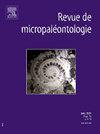巴西里约热内卢do Rasto组晚二叠世达尔文目(甲壳纲:介形虫目)
IF 1
Q4 PALEONTOLOGY
引用次数: 0
摘要
巴西古生代足类介形类的研究仍落后于中生代(主要是白垩纪)和新生代,且主要集中在帕拉南本文章由计算机程序翻译,如有差异,请以英文原文为准。
Late Permian darwinulocopines (Crustacea: Ostracoda) from the Rio do Rasto Formation, Brazil
The study on Paleozoic podocopid ostracods in Brazil still lags behind the Mesozoic (mainly Cretaceous) and Cenozoic ones, and is mostly concentrated in the Paraná Basin. Consequently, we have only vague information about their diversity, distribution, and affinities to the North Hemisphere assemblages. In order to contribute to the improvement of this knowledge, this work presents a study on Late Permian Darwinulocopina from the Rio do Rasto Formation, Paraná Basin, Brazil. The vertebrate fauna associated indicates a Lopingian age for these deposits which are interpreted as a delta front to delta top environment. Nine species of darwinulocopines were recorded in the studied sample, some of them very abundant, while others very rare and represented only by a few specimens. The superfamily Darwinuloidea is represented by the genera Paleodarwinula Molostovskaya and Wjatkellina Molostovskaya, and the Suchonelloidea is represented by the genera Dvinella Molostovskaya and Prasuchonella Molostovskaya. Two new species are described: Paleodarwinula moliyae nov. sp. and P. gregorysohni nov. sp. Additionally, the occurrence of two species previously described from the Eastern European Platform (Wjatkellina fragiloides Zekina and Prasuchonella sulacensis Starozhilova) and one described in North America (Paleodarwinula hollandi [Scott]) demonstrate possible biostratigraphic and paleoenvironmental comparisons between the Paraná Basin and Russian Platform Assemblages, as well as North American ones.
求助全文
通过发布文献求助,成功后即可免费获取论文全文。
去求助
来源期刊

REVUE DE MICROPALEONTOLOGIE
PALEONTOLOGY-
CiteScore
2.50
自引率
0.00%
发文量
17
期刊介绍:
La Revue de micropaléontologie publie 4 fois par an des articles de intérêt international, consacrés à tous les aspects de la micropaléontologie. Les textes, en anglais ou en français, sont des articles originaux, des résultats de recherche, des synthèses et mises au point, des comptes rendus de réunions scientifiques et des analyses de ouvrages. La revue se veut résolument ouverte à tous les aspects de la micropaléontologie en accueillant des travaux traitant de la systématique des microfossiles (et de leurs équivalents actuels), des bactéries aux microrestes de vertébrés, et de toutes leurs applications en sciences biologiques et géologiques.
 求助内容:
求助内容: 应助结果提醒方式:
应助结果提醒方式:


